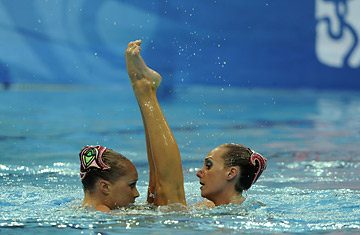
USA's duet team of Christina Jones, left, and Andrea Nott, right, compete during the final of the duet free routine in synchronized swimming.
There's no question they're athletic, these muscled, agile women competing in Beijing. But the question remains: Should synchronized swimming and rhythmic gymnastics remain Olympics sports? Both disciplines came of age in a not-so-distant era when women weren't allowed to lift weights or pole vault or compete in the triathlon — all of which were inaugurated as female Olympic sports only as recently as 2000. (In the first modern Olympics in 1896, women were excluded altogether.) But today, with Title IX — the education amendment that allocates funds equally between genders — an entrenched part of American schools, and even Afghan and Omani women competing in the 100m dash, does it make sense to keep a pair of women-only sports in the Olympics?
I think not. The problem with both events, in my mind, is that the girly bits overshadow the athletic parts. Synchronized swimming and rhythmic gymnastics involve such copious amounts of cosmetics that they make a Texas beauty pageant look sedate. Yes, thighs strain with effort, but I'm distracted by the twirling toes and the bleached teeth framed by rictus smiles. And the accoutrements of rhythmic gymnastics — the hoop, the swirling ribbon — divert from the balletic grace of the athletes.
At the synchronized swimming duet final on August 20, a pair of Chinese twins (Jiang Tingting and Jiang Wenwen), who came in fourth overall, performed a four-minute routine entitled "Little Birds Jumping and Flying Happily." During their turn, the Canadians blew water from their mouths, as if they were comely fountains spouting water. The Russians, who took the gold with straight 10s for technical merit, wore swimsuits with such variegated sequins that I failed to take note of what the two Anastasias (Ermakova and Davydova) were actually doing. I know immense physicality and endurance is involved in each routine, and that the smiles mask burning lungs. The Russians, for instance, are known to practice eight hours a day. But effort — and a discreet set of nose-clips — doesn't make it worthy of being an Olympic sport.
As with synchronized swimming, rhythmic gymnastics was added as an Olympic sport at the Los Angeles Games in 1984. The sartorial rules are strict: leotards must not stray into, god forbid, tutu territory. A brazen flash of a bra strap can even result in points subtracted from the gymnast's score. Curiously, in each Olympics, one of the five apparatuses isn't contested. In Athens, the clubs, which look like a pair of brightly hued bowling pins, didn't make an appearance. This year, it's the bouncy ball that's missing. Rhythmic gymnastics is certainly mesmerizing, but Cirque de Soleil mixed with a touch of the Bolshoi doesn't deserve a spot at the Games. Similarly, a budding campaign to make yoga an Olympic discipline should be quashed.
Currently, the only Olympic sport in which men compete and women don't is in boxing. (Baseball is only for men, but it has a female counterpart, softball. And, in any case, both sports will be eliminated from the Games after this Olympics.) My suggestion: Get rid of synchronized swimming and rhythmic gymnastics and bring in women's boxing. In Athens, women's wrestling was added for the first time. The sport now has an enthusiastic international following, from Japan and Kazakhstan to Spain and Canada. Outside of the Olympics, women's boxing is already a serious sport. If it is embraced by the International Olympic Committee for London 2012, a decision that would likely be made by the end of this year, the Games would achieve true equity. That should elicit some true joy, not a fleet of forced smiles.
